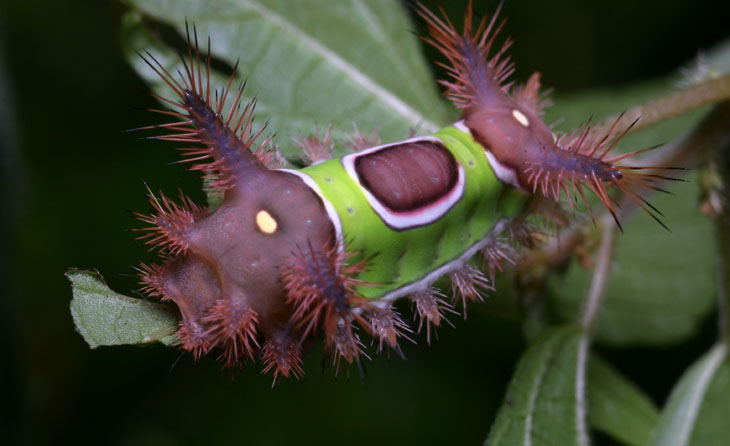
Almost two weeks ago, I spotted a couple of curious caterpillars on the undersides of some redbud leaves, right alongside the porch. Getting a good view of them required a particular angle, and I slid my legs off the porch into some deep weeds under the tree to crouch underneath my subjects. Soon afterward, I developed a sharp stinging sensation in my calf, similar to a honeybee sting but not nearly as painful – just irritating, with a tendency to surge at times. I searched carefully in the belief that I’d inadvertently contacted another of this spiky species, but found nothing.
This is a saddleback caterpillar moth (Sibine stimulea) larva, one of the many moths that gain their adult name from the appearance of their larval stage, and yes, those spikes are for defense. I confirmed this a few days later when looking for my subjects again (since I’d left them undisturbed on the redbud) – being incautious, I ended up brushing my finger directly across one as I turned over the leaf looking for it. The effect wasn’t immediate, which is curious, but it soon assured me that this was what produced the sensation earlier.
Then the appearance of one of my local residents, the only one I could find dependably, changed a bit. Apparently some wasp had not been terribly impressed with the caterpillar’s defensive mechanism – or, it might not have even encountered it.

Braconid wasps are a family of hymenoptera in the superfamily Ichneumonoidea, which anyone familiar with Darwin’s writings knows. They reproduce by parasitic means, laying their eggs within the bodies of caterpillars, whence the young will hatch out and consume the living tissues of the host before making their way to the skin and burrowing out. But instead of letting it go at that, they add insult to injury and spin their cocoons on the outer surface, pupating there until ready to emerge as an adult. The caterpillar, obviously in rough shape, will survive this ordeal for a while before succumbing. Some species lay their eggs in the caterpillar eggs themselves, hatching out after the caterpillar has hatched. Yes, it can be said (if you want to be emotionally manipulative) that it’s pitting child against child, since neither species accomplishes this in adulthood, but it’s also nature’s way of reining in caterpillars that can do a lot of plant damage, and believe me, there are some much nastier parasites out there.
Now, while doing that shot above, I had to switch out flash batteries, and fumbled one of the batteries out of my hand and into the thick weeds alongside the porch, right where I’d put my leg earlier. Lovely – I wasn’t going to get anything without the battery. I began poking around gingerly, wary of encountering another of those irritating little snots, and still couldn’t find it. In impatience I became less cautious, and was soon rewarded by yet another stinging sensation on my hand. The bright red battery couldn’t be located, but a tiny camouflaged caterpillar hiding under a leaf could. I eventually retrieved the battery with the help of a garden hoe.
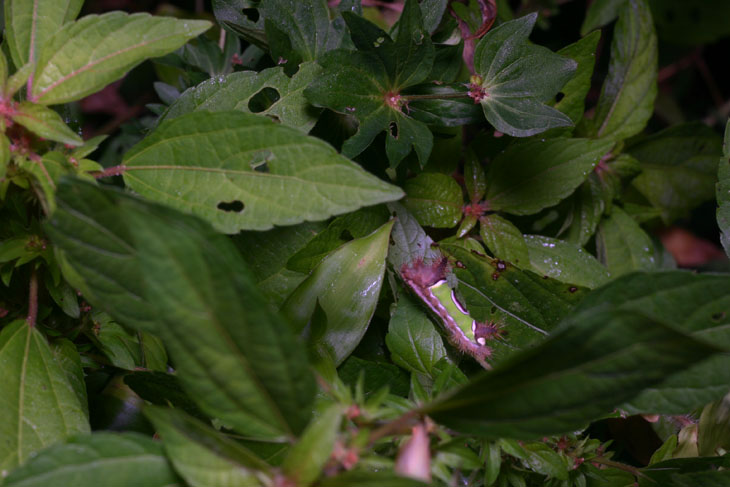
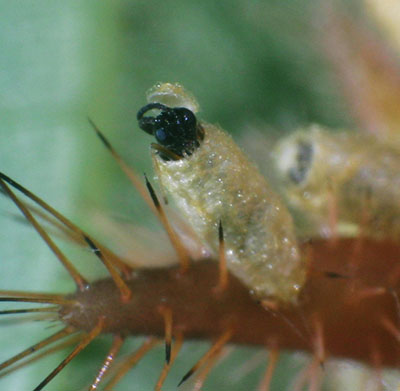 Anyway, the cocoons were an opportunity that I didn’t want to let slide, so I collected the leaf holding the saddleback caterpillar and put it in a jar on my desk to observe, with the intention of photographing the braconids emerging. A week went by with little to show, and the caterpillar didn’t change position at all, indicating that it was still alive only with some gentle rocking when disturbed. I was checking fairly frequently but, two days ago, spotted movement from the corner of my eye and found the jar full of tiny black insects, the size of small flying ants – just to let you know, the caterpillar measures 18mm in body length, add 15% for spikes, and the cocoons and wasps a mere 2.5mm. I went outside and removed the leaf, releasing the newly emerged wasps as I did so, and was pleased to see that some cocoons had yet to hatch, so I set up in a comfortable camera position and waited.
Anyway, the cocoons were an opportunity that I didn’t want to let slide, so I collected the leaf holding the saddleback caterpillar and put it in a jar on my desk to observe, with the intention of photographing the braconids emerging. A week went by with little to show, and the caterpillar didn’t change position at all, indicating that it was still alive only with some gentle rocking when disturbed. I was checking fairly frequently but, two days ago, spotted movement from the corner of my eye and found the jar full of tiny black insects, the size of small flying ants – just to let you know, the caterpillar measures 18mm in body length, add 15% for spikes, and the cocoons and wasps a mere 2.5mm. I went outside and removed the leaf, releasing the newly emerged wasps as I did so, and was pleased to see that some cocoons had yet to hatch, so I set up in a comfortable camera position and waited.
The first thing that happened was that my preferred flash setup quit working and wasn’t going to be fixed easily, so I was forced to switch to another system which produced harsher light with deeper shadows. I tried supplementing with a second, slave strobe to even this up, which resulted in getting some glare into the lens and putting a faint fog over the images – what you see here has been tweaked a little. Yet the wait was relatively brief before another started to emerge. Above, the head is just visible, with the ends of the antennae still not free and forming loops. My experience with assassin bugs and lady beetles hatching told me this was going to be a slow process. I should have realized that hatching from an egg is different from emerging from a chrysalis.
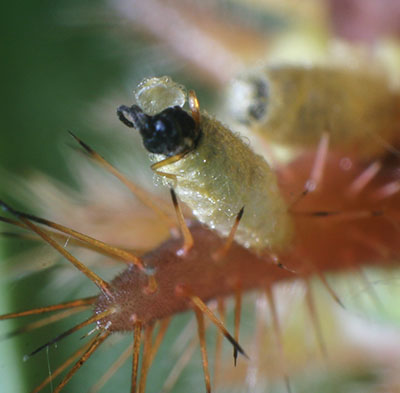 I missed prime focus on this one, but you can see the two forelegs have gotten free and are applying some leverage. It’s three minutes and forty seconds between the image above and this one – anyone choosing to show the event would be more inclined to use time-lapse imagery rather than video. Not that that would have worked, since the host caterpillar was responding to the movement or irritation and was rocking again, making my attempts to hold focus even more challenging than normal.
I missed prime focus on this one, but you can see the two forelegs have gotten free and are applying some leverage. It’s three minutes and forty seconds between the image above and this one – anyone choosing to show the event would be more inclined to use time-lapse imagery rather than video. Not that that would have worked, since the host caterpillar was responding to the movement or irritation and was rocking again, making my attempts to hold focus even more challenging than normal.
Then the second light shifted on its stand, and I spent thirty seconds adjusting it back into position, figuring I wasn’t going to miss anything. Turning back, I was greeted with a wasp running around on the spines hyperactively, without the slightest sign of sluggishness or even stretching. This was so unexpected I had to check the cocoon carefully to be sure I wasn’t seeing another wasp who had come back in a fit of nostalgia. Nope; after dragging its heels (or whatever) for the first stage of emergence, it made up for it just when I was occupied with something else.
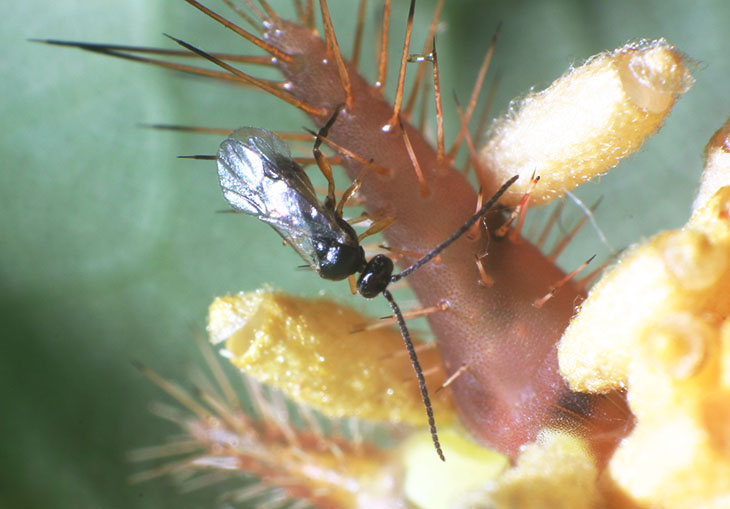
No matter; I still had five cocoons telling me, through their intact caps and dark shadows within, that I could still get a good photo sequence. I waited, determined to improve my patience for the good of the pursuit. While we’ve been dealing with storms for days, the sun came out that morning. I sweated profusely, and started to burn. I took a phone call while out on the porch leaning over the caterpillar, who had taken to occasionally pirouetting clumsily in place as if confused. The sky clouded up, and eventually the rain, then a downpour came, making me have to move further under the awning and wrecking the light. I could see twitching of some of the remaining cocoons – I could never determine if this was caused by the occupant or the caterpillar it was anchored to. Yet, still no real action. I chased a nearby crab spider, and a hornworm, and lots of red ants on foraging expeditions that scampered unconcernedly up my legs. I used a raindrop as a lens to photograph one of the cocoons I was observing.

What I’m trying to say here is I spent much of the day watching for another hatching and achieved nothing for it, eventually abandoning my watch to do frivolous things like eat and treat a sun-exposure headache (my legs have a very curious pattern on them right now.) While away, two more cocoons hatched, leaving me with three remaining. I put the leaf away in the evening and came back to it yesterday morning, seeing no change, but then had to run out for several hours.
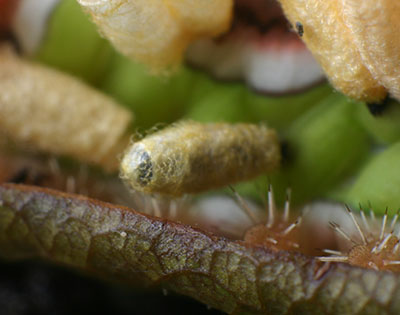 By the time I returned, of course, two more had hatched, so I released them and took up my post with the one remaining cocoon. By evening, I was pretty sure I was seeing movement caused from within the cocoon, and stayed put, practically going blind from watching. This may sound overly dramatic, but there’s a kernel of truth to it, a curious trait of our eyes that I’ve encountered a few times now. The retina requires constantly changing input to work properly; if it keeps receiving the same image, somehow its function fades and it actually stops registering anything at all, getting bored I guess. There’s evidence that micro-twitching of the eye, call microsaccades, help to prevent this, though this is disputed. Either way, I’ve found myself struggling to maintain focus and acuity when staring at a subject intent on the least indication of movement.
By the time I returned, of course, two more had hatched, so I released them and took up my post with the one remaining cocoon. By evening, I was pretty sure I was seeing movement caused from within the cocoon, and stayed put, practically going blind from watching. This may sound overly dramatic, but there’s a kernel of truth to it, a curious trait of our eyes that I’ve encountered a few times now. The retina requires constantly changing input to work properly; if it keeps receiving the same image, somehow its function fades and it actually stops registering anything at all, getting bored I guess. There’s evidence that micro-twitching of the eye, call microsaccades, help to prevent this, though this is disputed. Either way, I’ve found myself struggling to maintain focus and acuity when staring at a subject intent on the least indication of movement.
Night fell without event, and I even resorted to shining a UV flashlight on the cocoon hoping to induce a hatching – most hymenoptera can’t see jack at night, and my reasoning was that it wouldn’t hatch when it couldn’t fly away. This didn’t help, and I ended up restoring the leaf to its jar yet again.
This morning? Still there! I took it back out onto the porch to maintain my vigil, my last chance to do a good photo sequence. Primed by the pattern established by the previous one I’d actually witnessed, I figured I could check back frequently enough to catch the beginning of the emergence and still get a good series. So yes, clever you, you know what happened: in the space of two minutes or so, the last braconid burst its restraints and made its escape without giving me the faintest glimpse.
The caterpillar yet remains alive as I type this, but hasn’t fed for over a week and barely moves – it’s not long for this world. Since it will make a nice illustration (given the lack of good images,) I’m probably going to preserve it, though whether this is in alcohol, by attempting to freeze-dry it, or by encasing it in clear acrylic I haven’t yet decided. What I do know is that the results of my clinical testing of patience remain inconclusive.




















































